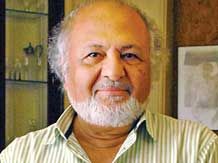 | « Back to article | Print this article |
Advertising is a team business and the firepower few admen bring is unheard of, says Mohammed Khan.
 I came to India in 1971, after working in London for about eight and a half years. Most of the leading advertising personalities had a theatre background .
I came to India in 1971, after working in London for about eight and a half years. Most of the leading advertising personalities had a theatre background .
The biggest change that advertising saw was that we had to earn our respect - for our craft from marketing managers at a time when advertising was a luxury and not a necessity.
It was a seller's market as there was a shortage of goods.
Where are the alternatives?
In the early to mid seventies, agencies would give clients options for one campaign.
The client would pick and choose the headline from one, the photo from another.
But my London days had taught me that advertising empires were built by solving client's problems and not like this.
There was no room for vacillations. You had to believe in what you did. Tarun Gupta, one of the brightest marketing people in the country then, with Glaxo (GlaxoSmithKline) saw the point.
Glaxo was a large account, over Rs 30 lakh in those days. He asked me for alternatives, I said that they were in my bin, because I had rejected the others.
He insisted, so I sketched 30 options on large sheets and spread them across his office the next day. After rounds of shortlisting, he finally chose the one I had shown in the first place.
From that day he agreed not to ask for alternatives. Thus started the process of earning respect from clients and standing by one's work. Credit also goes to the client's sense of fair-play. He did not have ego issues.
But in terms of demanding choice, the industry seems to have gone back to those days. Right from clients calling for a pitch with multiple, disparate agencies to having consultants from one agency on an account that is officially another's.
Ad craft
.jpg?w=670&h=900) I joined Sylvie daCunha (Sylvester daCunha, creator of the Amul Girl) as he was doing the Amul advertisments.
I joined Sylvie daCunha (Sylvester daCunha, creator of the Amul Girl) as he was doing the Amul advertisments.
They were the most creative, visible and captured people's imagination (many drove to Marine Drive to see what the new hoarding said).
But most other ads consisted of the client's brief pasted on a layout. So, the transition of ad craft from ensuring people buy your soap without actually saying, 'please buy my soap' had to happen.
London advertising then was probably one of the best eras the world has seen. This was way after David Ogilvy's time.
'The pregnant man' (by Jeremy Sinclair, who worked with the Saatchis and wrote it while in its forerunner, Cramersaatchi) was out by then.
There I would ask questions like why this typeface and why not that picture of my art director. So I ended up bringing in industry-firsts to India too.
When working with Sylvie, I wrote a script for an in-cinema ad for Lakme (then owned by Tata) talcum powder.
There were just three ad film-makers and they turned down my request to have sync sound (recording as the models speak on camera and not dub them) saying it was never done before, even though we had a large film industry. But I did it with the help of a friend and others soon followed suit.
Similar with ads with photographic ideas, than just mug-shots of mangalsutra-clad housewives.
The whole attitude of what could be done got changed in the 1970s.
Next change
The next transition came with founding new agencies. I found my partners for Rediffusion, (floated in 1973) when I joined MCM. It had the most visible advertising.
Ajit Balakrishnan and Arun Nanda were brilliant. Advertising is a team business and the firepower they brought was unheard of.
It established that agencies could be lean, rather than fat cats of those times.
By the time I set up Contract, HTA's second agency, in 1978, the process of earning respect for creative work went a step further.
In its first financial year, it made almost as much as HTA (on a crore turnover vs 30-40 crore turnover of HTA) and won 80 per cent of the awards.
We were charging a creative fee, Rs 6,000, a princely sum. I told clients that if the work failed, the agency should be fired, but they had to pay for good creatives.
So, advertising started becoming more about the work you do, something that came a full circle in the nineties when clients sought out the agencies for good work.
Things have changed now, and most of the business is dictated by media agencies.
With TV in the eighties, there came money muscle. But we had to tell clients that spending a load of money will get you some impact but brand engagement depended on the idea.
So, for Charms (VST) and Vadilal, who did not have deep pockets, we cracked the market with the help of ideas alone.